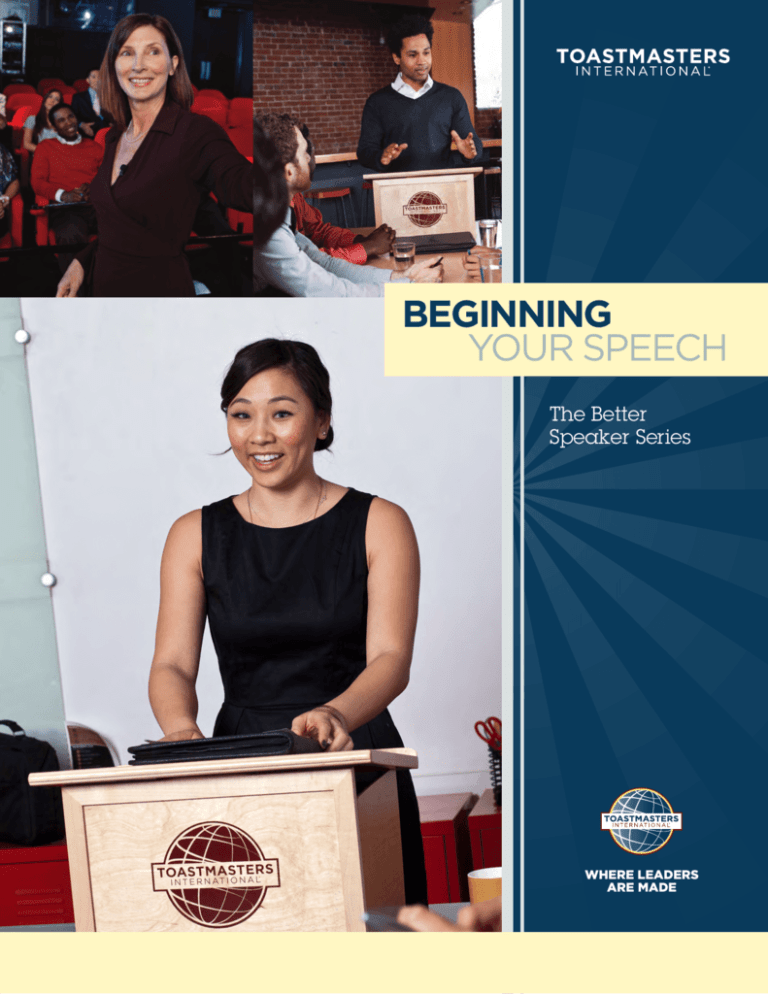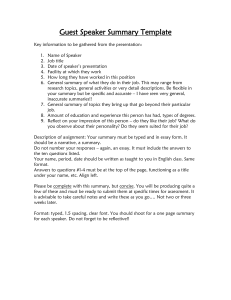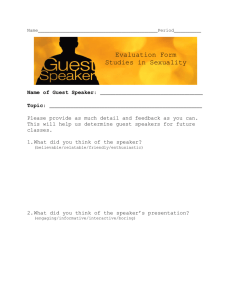
BEGINNING
YOUR SPEECH
The Better
Speaker Series
WHERE LEADERS
ARE MADE
BEGINNING YOUR SPEECH
The Better Speaker Series
TOASTMASTERS
INTERNATIONAL
P.O. Box 9052 • Mission Viejo, CA 92690 • USA
Phone: 949-858-8255 • Fax: 949-858-1207
www.toastmasters.org/members
© 2011 Toastmasters International. All rights reserved. Toastmasters International,
the ­Toastmasters International logo, and all other Toastmasters International
­trademarks and copyrights are the sole property of Toastmasters International
and may be used only with permission.
Rev. 5/2011 Item 270A
WHERE LEADERS
ARE MADE
THE BETTER SPEAKER SERIES
Toastmasters International’s The Better Speaker Series is a set of presentations offering instruction
on basic speaking skills. Designed to be delivered by members to their clubs, presentations in this
series provide new speaking techniques and facts that can help all club members develop their
communication skills.
Presentations in The Better Speaker Series may be delivered by any club member and require 10
to 15 minutes to present.
CONDUCTING THIS PROGRAM
“Beginning Your Speech” emphasizes how a speaker’s opening words are critical. By providing
proven criteria and techniques for speakers to apply and practice, speakers can win their audiences
with their opening remarks. This product consists of four parts:
Definition and explanation of the presentation
Guidelines for your introduction to the audience
Outline for the development of your speech
CD of a PowerPoint presentation to be viewed along with your speech
In Your Own Words
The outline is not a script and should not be read word-for-word. Instead, use the
document as a guide for presenting the material in your own words and with your
own narrative style. The presenter’s outline is a structure on which to build your
presentation. Use the points of the outline to develop your speech, but be the author
of your own oration.
Here are­tips on using this program to develop and deliver your presentation:
Study the outline carefully. Familiarize yourself with the general structure. Preparation is the
key to a successful presentation.
Use the outline to build your own speech using your own words. Prepare a set of notes indicating where you wish to pause, gesture, or add special verbal emphasis. Highlight key words
or sentences to help you present the material most effectively.
When delivering your speech, be expressive. Use all of the presentation skills you have learned
as a Toastmaster, including vocal variety and gestures.
USING VISUAL AIDS EFFECTIVELY
Visual aids add interest to any presentation and help your audience retain information. You are
encouraged to use them. If you plan to use the PowerPoint slides for this presentation as visual aids,
you will need a data projector, a laptop computer, a table to support them, and a screen for viewing.
In the outline, there are indications for placement of the PowerPoint slides. Each is numbered.
For example, V1 refers to visual number one.
2 THE BETTER SPEAKER SERIES 4 BEGINNING YOUR SPEECH
Please note that the first slide in the PowerPoint show is a title slide and is not included in this
­numbering system.
If you cannot arrange for projection equipment but still would like to use visuals, you may copy
the material on the visuals onto a flipchart. Do this before the presentation. Use a heavy marking
pen that does not seep through the paper, and write on every third or fourth page so succeeding visuals will not show through. Also, make your letters large and heavy with plenty of space
between them.
Follow these tips when using visual aids:
Set them up and test them before the meeting begins. Place them so they are easily visible
to listeners. Place your projector so it projects a large, high, undistorted image on the screen.
Focus the image.
Bring spare equipment, including a projector bulb, extension cord, and extra marking pens.
Display your visuals only when they are needed. If you are using a flipchart, flip the page back
out of view when you are finished with it.
Remember not to stand between the screen or flipchart and your audience or you will block
their view.
Maintain eye contact with your listeners. Do not talk to the screen or flipchart. If you must turn
your back to point out something, pause as you point it out, and then resume speaking only
after you are once again facing your audience.
EVALUATION AND THE ADVANCED COMMUNICATOR SILVER AWARD
Because this is an outlined presentation, for presenting it you will not receive credit toward
­completing a manual speech project, but you may receive credit toward your Advanced
Communicator Silver (ACS) award. Ask your vice president education to assign an evaluator for
your presentation.
Conducting any two programs from The Better Speaker Series and/or The Successful Club
Series is one component of qualification for ACS recognition. For further details, please visit
www.toastmasters.org/membereducation.
THE BETTER SPEAKER SERIES 4 BEGINNING YOUR SPEECH 3
BEGINNING YOUR SPEECH
Introducing the Presenter
TIPS FOR THE PRESENTER: WRITE YOUR INTRODUCTION
All prepared speeches in Toastmasters require an introduction. A proper introduction of you and
your speech is important to the success of your presentation. Use the following as a guide in writing
your introduction:
Include the purpose of The Better Speaker Series.
Explain why “Beginning Your Speech” is important for a Toastmasters club, stating the purpose and one or more objectives of your presentation.
Incorporate some personal background.
Read When You’re the Introducer (Item 1167E) for further details about giving a proper
introduction.
Give your finished introduction to the person who will be introducing you.
TIPS FOR THE INTRODUCER
Ask the presenter any clarifying questions.
Rehearse the introduction.
4 THE BETTER SPEAKER SERIES 4 BEGINNING YOUR SPEECH
BEGINNING YOUR SPEECH
Outline
INTRODUCTION
The first moments of a speech are critical to its success. If they are dull, lifeless, and unimaginative,
the audience can lose interest in the rest of the speech. However, an exciting, creative beginning
will help grab and keep listeners’ attention.
THE CRITERIA FOR A SUCCESSFUL OPENING
Successful speech openings meet four criteria:
V1
1. Get the attention of the audience. A listener’s attention needs to be refocused away from any distractions and toward the speaker. A good beginning draws the audience’s attention to the speaker and the presentation.
2. Introduce the topic. The beginning of a speech should indicate what the speaker will be talking about and why the audience should be interested in it. When listeners understand the topic
and how they will benefit from listening to a speech, they will immediately pay close attention.
3. Establish rapport. The audience will be more receptive to the speaker and the message if the
speaker appears friendly and interested in them and shows personal interest in the subject.
Effective ways to establish rapport with an audience:
Smile.
Show enthusiasm.
Make eye contact.
4. Take less than five to 10 percent of the entire speech time. The majority of the time should
be spent focused on the body of the speech.
OPENING TECHNIQUES
Techniques for opening a speech can help calm the speaker’s nerves and give clarity of mind.
Techniques can also generate new ideas over time. The following seven techniques will help a
speaker create good speech openings:
Presenter
Personalize the following techniques by referring to speech beginnings given by
fellow club members. For example, if a club member began a speech last week with
an anecdote, use this anecdote as an example when discussing Technique 4, “Tell a
story or anecdote.”
THE BETTER SPEAKER SERIES 4 BEGINNING YOUR SPEECH 5
V2
1. State the importance of your topic. Tell your listeners why the topic is important to them.
E xample: In a speech concerning overexposure to the sun, the speaker may begin by saying, “A
golden tan may be glamorous, but overexposure to the sun can age your skin prematurely and
can cause skin cancer. Thus, it’s important to protect yourself from the harmful rays of the sun.”
V3
2. Make a startling statement. Startle your listeners with an intriguing statement that will compel
them to listen further.
E xample: “Smoking kills! More Americans die each year than were killed in battle during World
War II and Vietnam together.”
V4
3. Arouse suspense or curiosity. Use a series of statements related to the topic that will pique your listeners’ interest.
E xample: A speaker could begin a speech by saying (using a feline tone of voice and body
gestures), “I enjoy lying around the house all day. I do not care if you never come home as long
as my food is available, because I have fun by myself. I like to chase my tail and stalk imaginary
animals. As you may have already guessed, I am a cat.”
V5
4. Tell a story or anecdote. Telling an amusing tale, dramatic story, or anecdote arouses interest
and gets an audience involved. Keep the story or anecdote relevant to the main point of the speech, and personalize it whenever possible.
E xample: Instead of beginning, “Two men were hunting in the woods one day…,” say, “My
brother and I went hunting last week in the woods behind my house.”
V6
5. Ask a rhetorical question. Ask one question or a series of questions that relate to your speech
topic. The audience will think about an answer and thus your topic.
E xample: In a speech about first aid, a speaker could begin by asking, “Do you know what to do
if your child begins to choke?”
V7
6. Begin with a quotation. Using a quotation is an easy and effective way to attract attention.
Keep quotes short and related directly to the speech topic.
Sources of quotations:
■■ Friends
■■ Family
■■ Co-workers
■■ Internet
■■ Books
■■ Magazines
■■ Television
■■ Radio programs
Quotations enhance speeches:
■■ Added authority
■■ Amusement
■■ Dramatized points
6 THE BETTER SPEAKER SERIES 4 BEGINNING YOUR SPEECH
Example: A speech on leadership could begin, “Dwight D. Eisenhower, 34th President of the
United States once said, ‘You do not lead people by hitting them over the head – that’s assault,
not leadership.’ We are looking for leaders to inspire and motivate – not assert themselves and
make demands. It’s crucial for leaders to bring those whom they lead to an equal playing field
into mutuality.”
7. Reference the occasion. Begin the speech by acknowledging the occasion. This type of beginning allows a speaker to recognize an important or unusual event and to establish a common
interest with the audience.
V8
Example: A speech given at the opening of a new school:
“Ladies and gentlemen, five years ago we were told by our town council that we had no money
to build a new elementary school. We were told that our children had to continue attending
a 75-year-old school that had only four classrooms. Today, we stand before our brand new
elementary school – a place where the children of this growing community will be educated for
years to come. We are proud that the members of this community worked together to accomplish what some said could not be done.”
OTHER TECHNIQUES
V9
The above techniques are the most frequently used approaches, but they are not the only techniques a speaker can use for effective speech openings:
Humor
Audience participation
A demonstration
A reference to a historical event
Whatever technique you choose, ensure it is relevant to the topic, to the audience, and to the
occasion.
Memorize
Once you have written the beginning, memorize it so you do not have to refer to
notes. A memorized, polished introduction helps to establish credibility and rapport
with your audience.
THE BETTER SPEAKER SERIES 4 BEGINNING YOUR SPEECH 7
V10
OPENINGS TO AVOID
Just as there are positive techniques to practice and keep in mind, it is also important to avoid techniques that will distract an audience:
Avoid acknowledging the amount of preparation. The audience does not need to know
how much a speaker has prepared for the speech he or she is giving. Unless the amount of
time specifically pertains to the speech, it should not be addressed. If a speaker has spent little
time preparing and states that fact, the speaker may invalidate his or her expertise with the
audience and lose his or her authoritative voice.
Example: “Thank you all for coming. I haven’t really had a chance to prepare.”
Avoid being dull and boring. Listeners need to be captivated, informed, inspired, and motivated. A speaker’s hope is to accomplish this from the beginning of the speech. Stay away
from a bland beginning.
Example: “Today, my speech is about the breakthrough of medicine.”
Avoid delaying mention of the topic. Some speakers think that delaying mention of the
topic creates anticipation and arouses curiosity, but this is not so. If the audience does not
know the subject matter and purpose of the speaker’s message, they will immediately lose
focus.
Example: “You have all come to this conference in anticipation of delving deeper into
the theme of education. The title of my speech is [pause]. Well, we’ll get to that in a few
moments.”
Tip
Some people write the beginning of a speech after they have developed the body
because they can then clearly identify the important points they want to emphasize.
By creating an introduction in this manner, a speaker can pinpoint what technique
would best suit the speech.
V11
CLOSING
A dynamic beginning is essential for a successful speech. Take the extra time to create an exciting, imaginative beginning that will grab your listeners’ attention and keep it focused on you. First
impressions can be lasting impressions. Ensure that the first impression is positive by using some of
the techniques discussed today.
8 THE BETTER SPEAKER SERIES 4 BEGINNING YOUR SPEECH
Evaluation Guide
Evaluator’s Name_________________________________________________________________
Presentation Title_______________________________________ Date _____________________
How effective was the speaker’s introduction in helping the audience understand the purpose of
The Better Speaker Series and the presentation itself?
Was the presenter adequately prepared? How heavily did the presenter rely on notes?
How did the speaker use vocal variety to enhance this presentation?
What other techniques did the speaker use to personalize and augment the presentation? Were
they effective? How?
Did the speaker display the visuals smoothly and at the appropriate times? How could the
speaker improve?
What aspect of the speaker’s presentation style did you find unique? Why?
Did the speaker present the material clearly and simply so audience members could easily use
the information to improve their own speeches?
What could the speaker have done differently to make the presentation more effective?
What did you like about the presentation?
THE BETTER SPEAKER SERIES 4 BEGINNING YOUR SPEECH 9
Notes
10 THE BETTER SPEAKER SERIES 4 BEGINNING YOUR SPEECH
Notes
THE BETTER SPEAKER SERIES 4 BEGINNING YOUR SPEECH 11
Notes
12 THE BETTER SPEAKER SERIES 4 BEGINNING YOUR SPEECH
www.toastmasters.org







